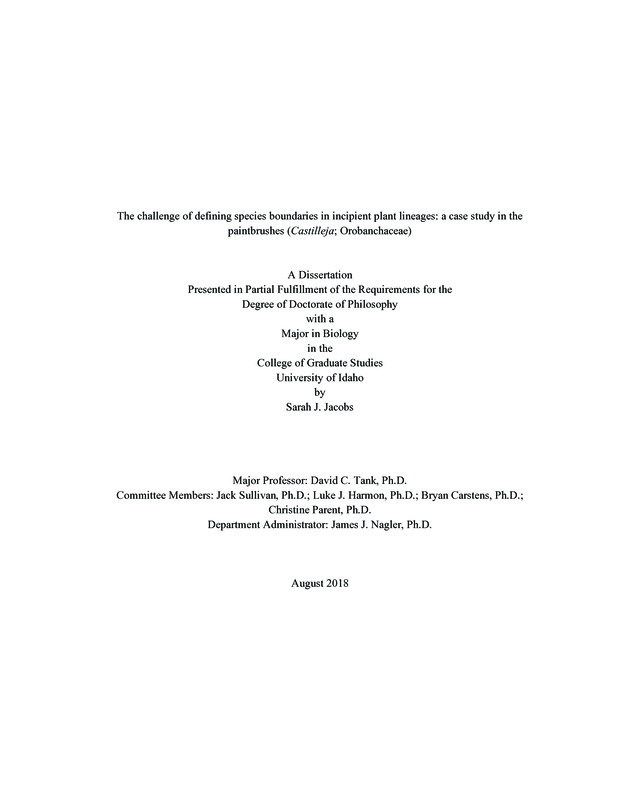The challenge of defining species boundaries in incipient plant lineages: a case study in the paintbrushes (Castilleja; Orobanchaceae)
Jacobs, Sarah. (2018-08). The challenge of defining species boundaries in incipient plant lineages: a case study in the paintbrushes (Castilleja; Orobanchaceae). Theses and Dissertations Collection, University of Idaho Library Digital Collections. https://www.lib.uidaho.edu/digital/etd/items/jacobs_idaho_0089e_11347.html
- Title:
- The challenge of defining species boundaries in incipient plant lineages: a case study in the paintbrushes (Castilleja; Orobanchaceae)
- Author:
- Jacobs, Sarah
- ORCID:
- 0000-0002-3125-6266
- Date:
- 2018-08
- Embargo Remove Date:
- 2020-07-08
- Keywords:
- Castilleja Orobanchaceae species delimitation
- Program:
- Biology
- Subject Category:
- Biology
- Abstract:
-
The genus Castilleja (also known as ‘the paintbrushes’) is an iconic and widespread group of plants. Infrageneric classifications in this young and rapid radiation have long been fraught with difficulty, mostly attributed to high incidence of polyploidy and interspecific gene flow when species co-occur. Subsequently, taxonomies have nearly continuous morphological and ecological diagnostic characters across species boundaries. This has resulted in the genus Castilleja being notoriously taxonomically difficult. During the course of my dissertation I have applied species delimitation to small species complexes to explore the capability of current approaches to delimit species in the face of tremendous amounts of interspecific similarity. Each of these complexes has required the use of suites of methods and analytical tools, some applied in new and novel ways, to delimit species. Recently, the use of multiple, independent approaches to molecular delimitation has been advocated as a means of accommodating the limitations of a single approach; however, this can result in incongruent delimitation schemes (i.e., where one approach delimits differently than another) with no widely used objective way to mitigate incongruence. The first chapter discusses the application of post-hoc simulations to address the capability of each approach to correctly delimit, particularly in the face of small sample sizes. Chapter two examines the application of environmental variables to the question of species boundaries. Given robustly estimated species ranges (using occurrence data from museum collections), I estimated niche models and extracted climatic variables associated with focal taxa to corroborate molecular species boundaries. The final chapter considers morphology as a line of evidence to define species boundaries. By quantifying the amount of morphological similarity in the pilosa species complex, I show that morphological characters do not distinguish taxonomic entities, suggesting little to no morphological distinction among species in this particular group. My work shows that when validating species boundaries in incipient lineages, multiple lines of evidence should be carefully scrutinized. Additionally, it is still unclear how best to reconcile incongruent delimitation schemes across multiple lines of evidence. Currently, fully integrated analyses are advocated, but in some cases, these reduce data to transformed variables that are difficult to interpret biologically
- Description:
- doctoral, Ph.D., Biology -- University of Idaho - College of Graduate Studies, 2018-08
- Major Professor:
- Tank, David C.
- Committee:
- Sullivan, Jack; Harmon, Luke J.; Parent, Christine; Carstens, Bryan
- Defense Date:
- 2018-08
- Identifier:
- Jacobs_idaho_0089E_11347
- Type:
- Text
- Format Original:
- Format:
- application/pdf
- Rights:
- In Copyright - Educational Use Permitted. For more information, please contact University of Idaho Library Special Collections and Archives Department at libspec@uidaho.edu.
- Standardized Rights:
- http://rightsstatements.org/vocab/InC-EDU/1.0/

